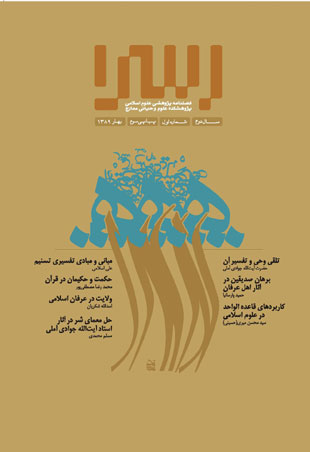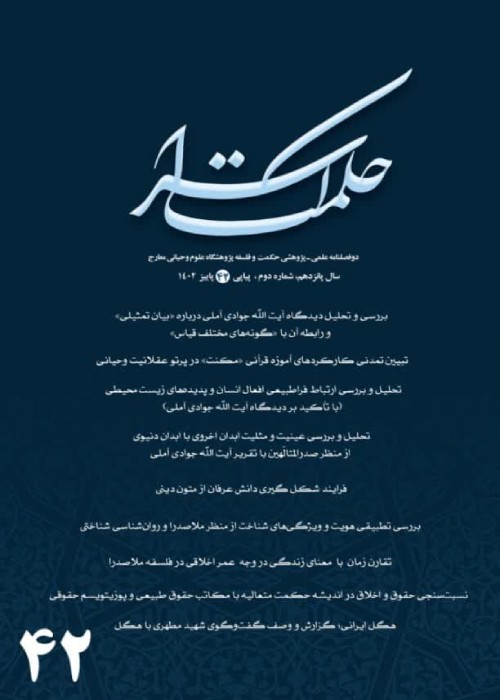فهرست مطالب

نشریه حکمت اسرا
سال دوم شماره 1 (پیاپی 3، بهار 1389)
- 152 صفحه، بهای روی جلد: 15,000ريال
- تاریخ انتشار: 1389/02/07
- تعداد عناوین: 7
-
-
صفحه 5آنچه درپی می آید، پیام حضرت آیه الله جوادی آملی مدظله العالی به کنگرهٴ بزرگداشت آیت الله آقامیرزا جواد تهرانی است. در این پیام ضمن تکریم آن فقیه و مفسر وارسته و تقدیر از برگزارکنندگان و حاضران در همایش برخی مبادی و نکات اساسی درباره قرآن کریم و فهم آن مورد بررسی قرار گرفته است.
کلیدواژگان: تحریف، تلقی وحی، عصمت وحی، فهم قرآن، مبادی وحی -
صفحه 17برهان صدیقین با این ویژگی که از واقعیتی خاص مثل حرکت و حدوث استفاده نمی کند، پس از بوعلی به عنوان یکی از برجسته ترین براهین مورد توجه قرار گرفت و در آثار فلسفی و عرفانی جهان اسلام محل بحث و گفت وگو قرار گرفت.
اهل عرفان ضمن نقد برهانی که بوعلی مطرح کرد، براهینی را با ویژگی برهان صدیقین اقامه کردند. این مقاله کار سلبی و ایجابی آنان را تا قرن دهم دنبال کرده، مورد بررسی قرار می دهد.
کلیدواژگان: برهان صدیقین، وجوب، امکان، الوهیت، شهود، برهان، حمل اولی و شایع، وجود مطلق، واجب -
صفحه 33دانشمندان اسلامی قاعدهٴ «الواحد» را در دانش های مختلف و موضوعات متعددی به کار گرفته اند. تبیین و بررسی برخی از کاربردهای قاعدهٴ الواحد در دانش هایی همچون مابعد الطبیعه، طبیعیات و اصول فقه، موضوع نوشتار حاضر است.
کلیدواژگان: قاعده الواحد، صادر اول، حقیقی، اعتباری، فلسفه، علم اصول، ادبیات -
صفحه 57تفسیر گرانسنگ تسنیم، محصول تحقیق، تنظیم و تدوین درس تفسیر قرآن کریم حضرت آیت الله جوادی آملی است.
از مهم ترین شاخصه های ساختاری و محتوایی تسنیم، روشمندی آن است. در این تفسیر، ذوق و سلیقهٴ شخصی، استحسانات عقلی و عرفی و پیش فرض های علوم گوناگون بر قرآن تحمیل نشده، دخالتی در تفسیر آیات ندارند. در نوشتار حاضر اصول و مبانی کلی حاکم بر شناخت و تفسیر قرآن بر اساس این کتاب قیم بررسی شده است.
کلیدواژگان: تسنیم، روش شناسی، اصول و قواعد تفسیر -
صفحه 71حکمت موهبتی الهی است که خدای سبحان آن را به هر کسی که بخواهد اعطا می کند. حقیقت حکمت، معرفت متقن و برهانی و عمل صائب و درست است که اگر کسی از آن بهره مند شود، به خیر کثیر دست می یابد. از آنجایی که اعطای حکمت از سوی خداوند گزاف نیست، افرادی می توانند از آن برخوردار شوند که زمینه های آن را در خود فراهم نمایند. از این رو انسان هایی چون انبیا و اولیای الهی و کسانی که رهرو راه آنها باشند، این شایستگی دریافت حکمت را پیدا می کنند.
کلیدواژگان: حکمت، حکمت نظری، حکمت عملی، معقول، موهبت الهی، انبیاء، لقمان -
صفحه 89اندیشهٴ ولایت در عرفان اسلامی، ساحتی الهی و حقانی از نظام عالم را به تصویر می کشد که در ورای همه مشبک های رنگارنگ، حقیقتی بی رنگ را که منشا پیوند انسان های کامل به حقیقت عالم است، به نمایش درمی آورد. جست وجو در منابع دینی و متون عرفانی و ارائه تصویر روشن از آن، و در عین حال بررسی اقسام و ابعاد ولایت، لوازم و مختصات آن در عرفان اسلامی، اهداف مقالهٴ حاضر می باشد.
کلیدواژگان: ولایت، ولی، قرب، سلوک، نبوت -
حل معمای شر در آثار اسناد ایت الله جوادی آملیصفحه 109هویت هستی شناختی و معرفت شناختی مقوله شر و پاسخ گویی به شبهات مربوط به آن در حوزه ذات، صفات و افعال الهی همواره مورد توجه اندیشمندان بوده است.بدین رو فیلسوفان و متکلمان برای دفاع از اصل بنیادین عدل الهی، پیوسته در مقام پاسخ به ایرادات بوده اند.
استاد متاله، آیت الله جوادی آملی با نگاهی جامع و مبتنی بر قرآن، برهان و عرفان، ضمن تبیین ماهیت شر و تفکیک میان راهکارها و فلسفه شرور؛ دو راهکار اساسی (عدمی بودن شر و دیگری نظام احسن) را برای حل مساله ارائه می دهند.جستار حاضر، به تبیین این امر در آثار استاد می پردازد.
کلیدواژگان: شر، وجود، عدم، نیستی انگاری، نظام احسن، آیت الله جوادی آملی
-
Page 5What follows is the message of ÀyatullÁh JawÁdÐ ÀmulÐ to the congress in honour of ÀyatullÁh ÀqÁmÐrzÁ JawÁd TehranÐ. In addition to extolling the late jurisprudent and exegete and thanking the conveners and participants of the symposium, the author goes on to investigate some of the fundamental matters concerning the Noble QurÞÁn and its understanding.
-
Page 17After the time of Avicenna, the Proof of the Truthful (burhÁn e ÒiddÐqÐn)—being unique in the fact that it does not use ideas of motion or contingency—became one of the outstanding proofs for the existence of God in the philosophical and mystical works of the Muslim world. The mystics, while critiquing the proof put forward by Avicenna, themselves produced proofs that had the characteristics of the Proof of the Truthful. The article at hand outlines and analyses both their criticisms and their new offerings to the field up until the tenth century of the Islamic era.
-
Page 33Muslim scholars have applied the Rule of ‘Al-WÁÎid’ to various sciences and subjects. The article expounds and analyses some of the usages of the Rule in such sciences as metaphysics, natural philosophy, and the principles of jurisprudence.
-
Page 57The eminent exegesis and commentary of the QurÞÁn entitled TasnÐm, is the product of the research and compilation of the lectures on the tafsÐr of the QurÞÁn by ÀyatullÁh JawÁdÐ ÀmulÐ. One of the most outstanding features of the TasnÐm is the method and order employed with respect to both content and structure. In this commentary, personal preferences, rational and popular vagaries, and the assumptions of various sciences have not been imposed on the QurÞÁn. The article at hand studies the general principles and sources that inform the proper understanding and exegesis of the QurÞÁn according to this exceptional book.
-
Page 71Wisdom is a divine gift granted to whosoever God wants. If a person acquires the reality of wisdom, which is informed by sound understanding and correct action, he has come by a ‘great good’ indeed. As the bestowal of wisdom on behalf of God is not a vain act, it stands to reason that the recipients of wisdom should strive to prepare the grounds and acquire the capacity to receive the same. Hence, it is the prophets and the saints, as well as their followers, who are worthy enough and who have the aptitude of wisdom.
-
Page 89The idea of ‘sanctity’ or ‘grace’ (walÁyah) in Islamic mysticism paints such a realistic and sacred picture of the universal order that it reveals the existence of a nexus that transcends all lower delimitations and that ties the Perfect Man to Reality as such. The article that follows goes through various religious and mystical texts so as to present a clear picture of walÁyah. It continues by investigating its various divisions and dimensions, as well as its concomitants and particularities in Islamic mysticism.
-
The Resolution of the Problem of Evil in the Works of Àyatullah Jawadi ÀmuliPage 109The ontological and epistemological roots of evil and the relevance of the problem to the divine essence, attributes and acts, has always warranted the attention of thinkers and intellectuals. Hence the field of theodicy and the continuous efforts of philosophers and theologians to defend the principle of divine justice by responding to the objections at hand. ÀyatullÁh JawÁdÐ ÀmulÐ approaches the problem of evil in a comprehensive way that is based upon the QurÞÁn, rational demonstration, and mysticism. He expounds on the nature of evil—making a distinction between the practical resolution of the problem and the philosophical causes of evil—and goes on to present two practical resolutions (evil as privation, and the ‘best order’ argument). The present study looks into how this problem is dealt with in the works of the ÀyatullÁÎ.


